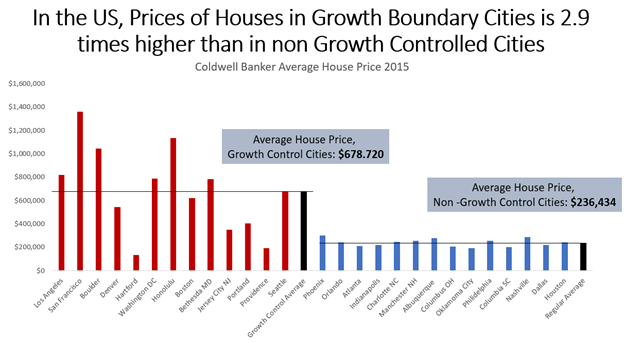Squamish needs more land for housing.
The guiding policy of our current OCP is “Infill only.” Only projects within our currently built boundaries will be smiled upon as locations for more housing by our planning department and council.
But if Squamish is going to maintain any type of housing affordability in the future, there is good evidence to suggest we need to move away from the tight, “Infill only” higher density plan currently in the OCP and move toward a more balanced policy of building beyond our growth boundaries— and open up more land for housing. This will release the pressure on our tight land base and curb the increase in housing prices.
Housing prices have risen fast in Squamish, but it was not supposed to be this way. With “Smart Growth” and density in our OCP, housing was supposed to remain affordable.
Is it just increasing demand? or have our “Growth Management Boundaries” (restricting building to only infill areas) contributed to making Squamish unaffordable for many who have lived here for a long time?
I was skeptical when I first heard the term “Smart Growth” because obviously, the PR people had got ahold of it and the name was chosen presumably to shut down any debate. Who wants to be in favour of the opposite?
However, I came to understand how, in theory, Smart Growth should reduce infrastructure costs, keep taxes down, and keep things affordable. In theory.
How are things stacking up a decade later? Has the theory been confirmed by real-world data?
Unfortunately for Squamish, there is now a lot of evidence that cities with rigid smart growth policies and restrictive growth boundaries have much higher housing prices.

Squamish is perhaps the worst place possible to implement strict growth boundaries. Within our current growth boundaries, we have riparian areas, an estuary, rivers, floodplain, debris torrent hazard areas, First Nations’ land, power line right of ways, rock walls, parks, railways, Agricultural Land Reserve, a major highway, and other environmentally or recreationally sensitive areas. These things all mean the land available for housing is even further diminished.
The price of available land goes up, and so does the price of housing. A lot.
Looking at over a decade of evidence and real data from housing markets, the data shows that rigid growth boundaries push housing prices up. A lot. And they push housing prices up faster than in communities without “Smart Growth” policies.
A recent U.S. study found that cities with “Smart Growth” policies saw housing prices increase 14 times more than cites without — a difference of almost $200,000 over a decade. (Find the study here: demographia.com/dhi-us8.pdf)
Based on Coldwell Banker 2015 U.S. data, the price of a benchmark two-bed- two bath house — in Growth Management Areas is almost triple — yes, triple the house price in non-growth management cities.
Vancouver and Toronto are the two cities in Canada that have seen the highest housing price increases, and they also have some of the most restrictive growth policies.
The assumption that Smart Growth keeps property taxes low is also questionable. An analysis of 700 municipalities concluded that higher density municipalities have the highest expenditures per capita. Saving a couple of hundred dollars in infrastructure costs per year does not help when your house costs $200,000 more than it would have otherwise. It turns out that upgrading old, in-fill infrastructure to handle higher density is often more expensive than building and maintaining brand new infrastructure.
The problem with Smart Growth — and economists across the political spectrum agree with this point — is that the whole idea is to restrict the supply of land available for housing.
When you restrict the supply, anything that is in demand, the price goes up. Add higher land prices, limited supply in Squamish, and the added costs of building in our area due to the floodplain, riparian areas and other features, and the costs to the builder, and therefore the buyer keep going up, making housing less and less affordable.
One of the findings of research institutes that have looked into why restricting land available for housing increases housing prices is that they create a magnet for investors. Those who invest in land or property can be certain that their land will increase in value over time, likely faster than other investments, as land in Smart Growth Boundaries is a commodity in increasingly limited supply.
This is great for investors but very bad for those who need a home.
As less and less land is available to develop in Squamish, there are development proposals next to the estuary, in debris torrent hazard areas, and high-density proposals near schools because these are some of the only lands left to develop, or that may be allowed within the current OCP guidelines.
Squamish is, as we all know, a great place to live. Demand for housing is going to continue to grow here, both as people discover it, and as those wanting to live near Vancouver get squeezed out. There is an opportunity to build a great community. But in the face of rising demand, only increasing the supply of land available for housing can stop housing prices from going up too fast. If we don’t increase the amount of land available for housing, prices in Squamish will continue to rise faster than anywhere else.
If our priority is to keep housing prices as reasonable as possible, Squamish should pursue a more balanced housing development policy, and allow more land on the outside borders of our current development areas to be built on in addition to some increase in density downtown. We can balance “density” and more land for housing. Our number one priority should be keeping housing affordable. If housing becomes unaffordable to the many people who live here or want to live here, Squamish will only be worse off for it.



